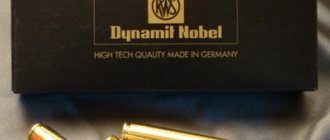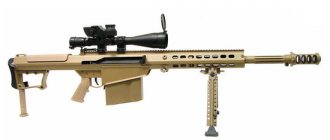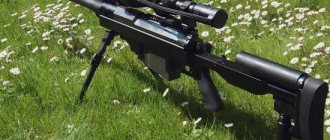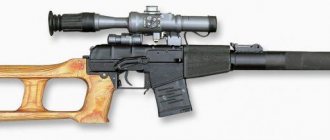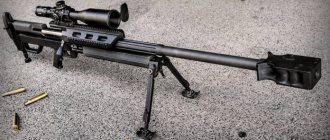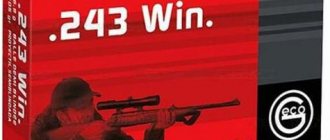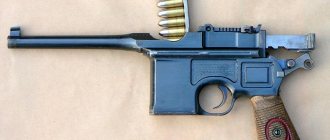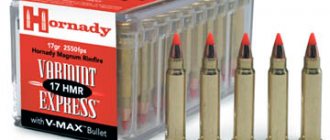Classification of firearms cartridges
| Caliber 6 mm | |
| Example of a 6 mm cartridge, .25 ACP caliber | |
| « 5 mm Firearms cartridges 7 mm" | |
This is a list of cartridges for firearms with bullets ranging in caliber from 6 millimeters (0.236 in) to 6.99 millimeters (0.275 in).
- Length
refers to cartridge case length - OAL
refers to the overall length of the cartridge.
Measurements in millimeters, then in inches, that is, in millimeters (inches) )
.
Pistol cartridges[edit]
| Name | Bullet | Length | Rim | Base | Shoulder | Neck | OAL |
| .25 ACP | 6,375 (0,251) | 15,62 (0,615) | 7,67 (0,302) | 7,06 (0,278) | N/A | 7,06 (0,278) | 23,11 (0,910) |
| .25 NAA | 6,375 (0,251) | 18,9 (0,744) | 8,6 (0,339) | 8,6 (0,337) | 8,5 (0,333) | 7,0 (0,276) | 24,4 (0,960) |
| 6.5 mm Bergmann | 6,706 (0,264) | 22,1 (0,87) | 9,4 (0,372) | 9,3 (0,368) | 8,4 (0,330) | 7,2 (0,285) | 31,2 (1,23) |
| 6.5 × 25 mm | 4,0 (0,157) | — | — | — | — | 29,7 (1,169) |
Rifle cartridges[edit]
0.24 inches (6.2 mm) [edit]
| Name | Bullet | Length | Rim | Base | Shoulder | Neck | OAL |
| .243 Winchester | 6,17 (0,243) | 51,94 (2,035) | 12.00 (.472) | 11,96 (0,470) | 11,5 (.454) | 7,01 (0,276) | 68,82 (2,709) |
| 6mm BR | 6,17 (0,243) | 39,6 (1,560) | 12.00 (0,4728) | 11,96 [1] (0,4709) | 11,6 (0,458) | 6,95 (0,274) | 62,00 (2,441) [1] |
| 6 × 45 mm SAW | 6,17 (0,243) | 45,01 (1,772) | 10,36 (0,408) | 10,26 | 9,72 | 6,63 | 65,44 (2,576) |
| 6mm PPC [2] | 6,172 (0,243) | 38,48 (1,515) | 11.30 (.445) | 11,20 (0,441) | 10,95 (0,431) | 6,654 (0,262) | 53,34 (2,100) |
| 6mm XC | 6,1722 (0,243) | 48,2092 (1,898) | 11,8872 (0,468) | 11,8364 (0,466) | 11,42 (0,450) | 6,8834 (0,271) | 71,3232 (2,808) |
| .243 WSSM | 6,1722 (0,243) | 42,42 (1,670) | 13,59 (0,535) | 14,1 (.555) | 13,82 (0,544) | 7,39 (0,291) | 59,94 (2,360) |
| 6mm ARC | 6,18 (0,243) | 37,85 (1,49) | 11.201 (.4410) | 11,2 (.441) | 10,924 (0,4301) | 6,96 (0,274) | 57,40 (2,260) |
| 6 mm Remington (.244 Remington) [3] | 6,18 (0,243) | 56,72 (2,233) | 11,99 (0,472) | 11,96 (0,471) | 10,89 (0,429) | 7,01 (0,276) | 71,76 (2,825) |
| .240 Wetherby Magnum [4] | 6,18 (0,243) | 63,40 (2,496) | 12.00 (.472) | 11,50 (0,453) | 10,40 (0,429) | 6,90 (0,272) | 80,00 (3,10) |
| 6 mm Creedmoor [5] | 6,182 (0,2434) | 48,77 (1,920) | 11,99 (0,472) | 11,946 (0,4703) | 11,735 (0,4620) | 7,01 (0,276) | 71,12 (2,800) |
| 24 Nosler [6] | 6,185 (0,2435) | 40,64 (1,600) | 9,60 (0,378) | 10,686 (0,4207) | 10,249 (0,4035) | 6,833 (0,2690) | 57,40 (2,260) |
| 6mm AR | 6,2 (0,243) | 38,7 (1,525) | 11.30 (0,4449) | 11,26 (0,4433) | 10,98 (0,4323) | 6,9 (0,271) | 57,4 (2,260) |
| 6 × 45 mm | 6,2 (0,243) | 45 (1,76) | 9,6 (0,378) | 9,6 (0,377) | 9 (0.354 in) | 6,9 (0,272) | 57,40 (2,260) |
| 6mm Lee Navy | 6,2 (.244) | 60 (2,35) | 11,4 (0,448) | 11,5 (0,443) | 10,2 (.402) | 7,1 (0,278) | 79 (3,11) |
| .240 Apex [7] .240 Magnum without rim .240 Magnum with H&H flanges 240 Apex .240 with Nitro Express belt | 6,223 (0,245) | 63,25 (2,49) | 11,86 (0,467) | 11,43 (0,450) | 10,24 (0,403) | 6,96 (0,274) | 81,53 (3,21) |
| .244 H&H Magnum | 6,223 (0,245) | 71 (2,78) | 13,5 (0,532) | 12,9 (0,508) | 11,3 (0,445) | 6,7 (0,263) | 91 (3,58) |
0.25 inches (6.5 mm) [edit]
| Name | Bullet | Length | Rim | Base | Shoulder | Neck | OAL |
| .25-25 Stevens | 6,5 (0,257) | 60,2 (2,37) | 9,6 (0,376) | 8,2 (0,323) | — | 7,2 (.282) | 66,8 (2,63) |
| .256 Win Magnum | 6,528 (0,257) | 32,54 (1,281) | 11,18 (0,440) | 9,677 (0,381) | 9,347 (0,368) | 6,528 (0,257) | 40,39 (1,590) |
| .25-45 sharp objects | 6,53 (0,257) | 44,7 (1,76) | 9,6 (0,378) | 9,6 (0,376) | 8,99 (0,3539) | 7,2 (.284) | 57,4 (2,26) |
| .25 Remington | 6,54 (0,257) | 52,1 (2,05) | 10,6 (0,419) | 10,6 (0,419) | 10,1 (0,396) | 7,3 (0,286) | 64,3 (2,53) |
| .257 Wetherby Magnum [8] | 6,535 (0,2573) | 64,74 (2,549) | 13,50 (0,5315) | 12,997 (0,5117) | 12,49 (0,492) | 7,24 (0,285) | 81,51 (3,209) |
| .25-06 Remington [9] | 6,541 (0,2575) | 63,35 (2,494) | 12,01 (0,473) | 11,94 (0,470) | 11,20 (0,441) | 7,37 (0,290) | 82,55 (3,250) |
| 255GS [10] | 6,54 (0,257) | 55,00 (2,165) | 12,20 (0,480) | 12,20 (0,480) | 11,58 (0,456) | 7.38 (0.291), tapering to 7.33 (0.289) | 72,50 (2,854) |
| .25 WSSM [8] | 6,541 (0,2575) | 42,42 (1,670) | 13,59 (0,535) | 14,097 (0,5550) | 13,826 (0,5443) | 7,595 (0,2990) | 59,94 (2,360) |
| .25-20 Winchester | 6,55 (0,258) | 33,78 (1,33) | 10,36 (0,408) | 8,86 (0,349) | 8,46 (0,333) | 6,96 (0,274) | 40,44 (1,592) |
| .25-35 Winchester [11] | 6,55 (0,258) | 51,89 (2,043) | 12,85 (0,506) | 10,73 (0,422) | 9,26 (0,365) | 7,15 (0,282) | 64,77 (2,55) |
| .250-3000 Savage [12] | 6,553 (0,258) | 48,46 (1,912) | 12,01 (0,473) | 11,91 (0,469) | 10,51 (0,414) | 7,26 (0,286) | 63,88 (2,515) |
| .257 Roberts [13] | 6,553 (0,258) | 56,72 (2,233) | 12,01 (0,473) | 11,99 (0,427) | 10,92 (0,430) | 7,36 (0,290) | 70,49 (2,775) |
0.264 inches (6.6 mm) and above[edit]
| Name | Bullet | Length | Rim | Base | Shoulder | Neck | OAL |
| 6.5 × 58 mm Vergueiro | 6,65 (0,262) | 57,85 (2,278) | 11,78 (0,464) | 11,88 (0,468) | 10,94 (0,431) | 7,56 (0,298) | 81,50 (3,209) |
| 6.5 × 55 mm Swedish (aka 6.5 × 55 mm Krag) | 6,7 (0,264) | 54,864 (2,16) | 12,192 (0,480) | 12,17 (0,479) | 10,688 (0,420) | 7,468 (0,294) | 80,010 (3,15) |
| 6.5 × 68 mm | 6,70 (0,264) | 67,50 (2,657) | 13.00 (.512) | 13.30 (.524) | 12,18 (0,480) | 7,60 (0,299) | 86,50 (3,408) |
| 6.5-284 Norm | 6,70 (0,264) | 55,118 (2,170) | 12,014 (0,473) | 12,725 (0,501) | 12,065 (0,475) | 7,544 (0,297) | 81,991 (3,228) |
| 6.5mm Remington Magnum | 6,70 (0,264) | 55,1 (2,170) | 13,51 (0,532) | 13,51 (0,532) | 12,6 (0,495) | 7,6 (0,298) | 71,1 (2,80) |
| 6.5-06 A-square | 6,70 (0,264) | 63,3 (2,494) | 12,014 (0,473) | 11,93 (0,470) | 11,24 (0,443) | 7,5 (0,296) | 87,3 (3,44) |
| .256 Newton | 6,70 (0,264) | 61,976 (2,440) | 12,014 (473) | 11,963 (0,471) | 10,617 (0,418) | 7,391 (0,291) | 86,36 (3,40) |
| .260 Remington | 6,70 (0,264) | 51,7 (2,035) | 12,0 (0,473) | 11,9 (0,470) | 11,5 (.454) | 7,5 (0,297) | 71 (2,8) |
| 6.5mm Creedmoor | 6,70 (0,264) | 48,8 (1,924) | 12,01 (0,473) | 11,9 (0,470) | 11,7 (0,459) | 7,54 (0,297) | 71,6 (2,82) |
| 6.5 × 47 mm Lapua | 6,70 (0,264) | 47 (1,9) | 12,01 (0,473) | 11,95 (0,470) | 11,53 (0,454) | 7,41 (0,292) | 70 (2,8) |
| 6.5 mm Grendel | 6,70 (0,264) | 38,7 (1,524) | 11,2 (.441) | 11,14 (0,439) | 10,87 (0,428) | 7,44 (0,293) | 57,5 (2,264) |
| .264 Winchester Magnum | 6,70 (0,264) | 64 (2,5) | 13,5 (0,532) | 13,1 (0,515) | 12,5 (.491) | 7,6 (0,299) | 85 (3,34) |
| 6.5×50mmSR Arisaka | 6,705 (0,264) | 50,39 (1,984) | 11,84 (0,466) | 11,35 (0,447) | 10,59 (0,417) | 7,34 (0,289) | 75,69 (2,980) |
| 6.5 × 54 mm Mannlicher–Schönauer | 6,705 (0,264) | 53,65 (2,112) | 11,52 (0,454) | 11,47 (0,452) | 10,87 (0,428) | 7,56 (0,288) | 76,77 (3,022) |
| 6.5 GAP 4S [14] | 6,71 (0,264) | 51,18 (2,015) | 13,56 (0,534) | 14.00 (.551) | 13,58 (0,535) | 7,42 (0,292) | 76,30 (3,004) |
| 6.5 Wetherby Precision Large Wine Bottle with Ribbed Hinge [15] | 6,71 (0,2640) | 65,3 (2,570) | 12,0 (0,473) | 12,70 (0,5000) | 12,04 (0,4739) | 7,49 (0,2950) | 84,8 (3,340) |
| 6.5 Cartridge for precision rifle [16] | 6,716 (0,2644) | 51,56 (2,030) | 13,51 (0,532) | 13,513 (0,5320) | 13,101 (0,5158) | 7,54 (0,297) | 75,06 (2,955) |
| 6.5-300 Weatherby Magnum [17] | 6,716 (0,2644) | 71,76 (2,825) | 13,50 (0,5315) | 12,997 (0,5117) | 12,498 (0,4920) | 7,493 (0,2950) | 91,44 (3,600) |
| 26 Nosler [8] | 6,718 (0,2645) | 65,79 (2,590) | 13,56 (0,534) | 13,970 (.5500) | 13,399 (0,5275) | 7,544 (0,2970) | 84,84 (3,340) |
| 6.5×53mmR | 6,756 (0,266) | 53,59 (2,110) | 13,40 (0,527) | 11,48 (0,453) | 10,75 (0,423) | 7,55 (0,297) | 77,56 (3,053) |
| 6.5 × 52 mm Carcano | 6,80 (0,268) | 52,50 (2,067) | 11,42 (0,450) | 11,42 (0,450) | 10,85 (0,427) | 7,52 (0,296) | 76,50 (3,012) [18] |
Forgotten Soviet 6x49mm cartridge versus 6.8mm NGSW cartridge
Consequences for the Russian Armed Forces in case of success or failure of the NGSW program
In the previous article, we looked at what actions could be taken in the event of a partially successful implementation of the Next Generation Squad Weapon (NGSW) program, when program participants are unable to create weapons that provide both a significant increase in range and high armor penetration, combined with sufficiently low recoil , and an acceptable mass of weapons.
In this case, the weapons created under the NGSW program will occupy a limited niche in the US armed forces in the form of the NGSW-AR light machine gun and the NGSW-R Marksman rifle. At the same time, the bulk of US military personnel will be armed with traditional weapons chambered for 5.56x45 mm caliber, or weapons chambered for slightly more powerful ammunition, for example, based on 6.5x39 Grendel or 6.8x43 Rem SPC cartridges.
The response of the Russian armed forces and industry in this case may lie in the area of relatively inexpensive evolutionary development of existing weapons, such as the Pecheneg machine gun, SVD / microwave sniper rifles and a Kalashnikov assault rifle or light machine gun, as well as ammunition for them in caliber 7, 62x54R, 7.62x39 mm or 5.45x39 mm.
However, if participants in the NGSW program are able to create a weapon that simultaneously provides a significant increase in range and high armor penetration, combined with sufficiently low recoil and an acceptable weight, simply improving existing weapons and ammunition will no longer be possible. In this article, we will consider what response options can be implemented by industry in the interests of the Russian Armed Forces.
As a preamble, we can cite the words of Alexei Sorokin, former director of the Tula TsKIB SOO: “It is obvious that promising small arms light weapons (SALW) systems should be built on the basis of new ammunition, since the potential for modernization of 5.45x39 mm and 7.62x54 cartridges mm is almost exhausted and still falls short of promising requirements. Several years ago, research work was carried out on a new ammunition for promising small arms and light weapons, and although, in my opinion, the work was interesting, the parent organization did a very poor technological job of producing a pilot batch of cartridges, and comparative tests did not show any advantages over existing ammunition, a negative result was made conclusion. Work was stopped. Discussion of a return to the 7.62x39mm cartridge is speculation. It will not be possible to obtain any significant advantages over 5.45x39 mm, and work on creating new ammunition for machine guns and sniper rifles and machine guns is not actively and systematically carried out.”
As we see, this is not the first time for Russia to borrow useful things from the West. But it’s not worth borrowing just the rifle caliber. It is better to start, for example, by at least partially creating the atmosphere of open and public discussion that accompanies similar work “at their place.” Moreover, it does not require additional money. On the contrary, by reducing efforts to classify everything, it will even be possible to save money. Unless, of course, it turns out once again that they were “secret” not from strangers, but from their own.”
TsKIB SOO, a branch of JSC KBP (Tula), is a developer of not only weapons, but also cartridges. The photo shows cartridges for underwater shooting PSP (with a tungsten alloy bullet) and PSP-UD for the double-medium ADS assault rifle of 5.45x39 mm caliber
And one more digression:
“In accordance with a request for information dated 07/08/2019, issued on July 8, the US Army Contracting Command, on behalf of the military research and production organization Picatinny Arsenal, wishes to receive from industry data on the possibility of manufacturing, the cost of carrying out testing and delivery of new 6.8 mm ammunition intended for use with weapons under the NGSW program.
Costs and estimates must take into account the use of equipment required to manufacture tungsten carbide
. "
Treasured 6.5 mm
Since the advent of the unitary cartridge for small arms, countless amounts of ammunition of various calibers and purposes have been produced.
Probably from that moment the search for ideal ammunition began, first for rifles and machine guns, and then for machine guns, which continues to this day not only on the pages of specialized Internet resources, but also within the walls of defense enterprises and institutes. Often, in the search for the “ideal” caliber, it is forgotten that the bullet diameter is only one of the characteristics of the ammunition, and cartridges with fundamentally different characteristics can be realized within the same caliber. Cartridges 7.92x57 mm and 7.92x94 mm with almost the same bullet, with initial energy, respectively, 3567 J and 10673 J
Often, the choice of optimal ammunition is surrounded by legends, one of which includes the widespread opinion that the ideal cartridge for an assault rifle should be the 6.5 mm caliber cartridge, proposed in 1913 by designer V.G. Fedorov in 1913, a 6.5x57 mm cartridge for an automatic rifle of his own design. For cartridge 6.5x57 mm V.G. Fedorov developed not only standard, but also armor-piercing bullets with tungsten alloy cores.
The 6.5x57 mm cartridge was never adopted by the Russian and then the Soviet army, and therefore we can only talk about its probable advantages in the format of an alternative history.
Patron V.G. Fedorov caliber 6.5x57 mm
At the end of the 19th and beginning of the 20th centuries, many 6.5 mm caliber cartridges were produced - the Italian 6.5×52 mm Mannlicher-Carcano cartridge, the Swedish 6.5×55SE mm Swedish Mauser, and the Japanese 6.5×50SR Arisaka , which V.G. Fedorov used a 6.5x57 mm cartridge in his rifle instead of his own.
Cartridges 6.5x50SR Arisaka, 6.5x52 mm Mannlicher-Carcano, 6.5x54 Mannlicher-Schonauer, 6.5x54R Mannlicher, 6.5x55 Mauser and 7.62x54R
Ultimately, the 20th century was dominated by 7.62mm and low-pulse 5.45/5.56mm cartridges by a huge margin. Considering the amount of money that the world's leading powers have invested in defense research, it can hardly be said that this choice is unreasonable.
However, history is moving in a spiral, and the development of promising 6-7 mm ammunition may be in demand in promising weapons.
Soviet legacy
In the USSR, systematic research was carried out on promising small arms and ammunition for them.
As could be seen from the previous article, The evolution of the assault rifle in the USSR and in Russia in the context of the American NGSW program, the scale of work carried out within the framework of the competition for the assault rifle for the “Warrior” equipment is not even close to comparable with what was implemented in the USSR, within the framework of solving a similar problem. An interesting ammunition for small arms, about which there is not enough information, is the 6x49 mm cartridge, developed in the late 80s of the 20th century by specialists from the Central Research Institute of Precision Engineering (TSNIITOCHMASH). The 6x49 mm cartridge is a rifle-machine-gun ammunition designed to hit targets protected by personal armor protection (PIB) at a range of up to 1000 meters. The predecessor of the 6x49 mm cartridge was the 6x54 mm cartridge, created back in 1975, with an initial speed of 5 gram bullets of 1080 m/s. The energy of the bullet of the 6x54 mm cartridge in some parts of the trajectory exceeded, and in others was comparable to the energy of the bullet of the 7.62x54R cartridge.
From left to right cartridges 7.62x54R, 6x54 mm, 7.62x39 mm, 5.45x39 mm
The 6x49 mm cartridge had higher performance compared to the 6x54 mm cartridge with smaller dimensions. A bullet weighing 5 grams accelerated to a speed of 1150 m/s, while the recoil impulse was 25-30% less than that of the 7.62x54R cartridge.
From left to right, cartridges 6x54 mm, 6x49 mm with an ordinary bullet with a steel core, 6x49 mm with an armor-piercing bullet with a steel core, 6x49 mm with an armor-piercing bullet with a tungsten-cobalt core, 6x49 mm with an ordinary bullet with a coated steel core, cartridge on the base 6x49 mm with a modified cartridge case and an experimental bullet with an enlarged core. For comparison, on the right is the 6.5 mm Fedorov cartridge
Cartridge 6x49 mm Prototypes of small arms have been developed for this cartridge - sniper rifles TKB-0145K developed by TsKIB SOO and SVK, SVK-S.
Experienced sniper rifles TKB-0145K and SVK, SVK-S
Apparently, the 6x49 mm cartridge is the most mature and promising ammunition developed in the USSR/Russia. How suitable is it for a weapon that can be considered as a competitor to an automatic rifle being created under the American NGSW program?
As we said earlier, in the event of negative results from the NGSW program, the bulk of US military personnel will be armed with traditional weapons chambered for 5.56x45 mm caliber, or weapons chambered for a reinforced cartridge based on cartridges such as 6.5x39 Grendel or 6.8x43 Rem SPC with an initial energy of 2000-2600 J. And in the case of a successful scenario, the initial energy of a promising 6.8 mm NGSW cartridge could be about 4300 J. This is significantly more than the 7.62x51 cartridge and even more than the .30-06 Springfield cartridge (7.62x63 mm), used in the American M1 Garand rifle.
Semi-automatic American M1 Garand rifle chambered for .30-06 Springfield
The initial bullet energy of the 6x49 mm cartridge is about 3300 J, it can probably be increased to 3500-3700 J. This is presumably lower than that of the promising American 6.8 mm NGSW cartridge, but there is a suspicion that it is one thing to want to get an automatic weapon chambered for a cartridge with an initial energy of 4300 J, getting it in reality is another matter. It is likely that the US military will have to “cut the sturgeon”, and in the development process the US will come to the same 3500-3700 J.
Another argument is that even if the Americans manage to create a weapon that allows firing in bursts with a cartridge with an initial energy of 4300 J, then at short ranges it will lose in accuracy to automatic weapons of a similar design, made on the basis of a cartridge with less energy. Thus, a weapon chambered for a 6.8 mm NGSW cartridge with an initial energy of 4300 J will have advantages at long range, for example, over 500 meters, when firing single shots, and a weapon created for a 6x49 mm cartridge with an initial energy of 3300 J will have advantages at shorter ranges, for example, up to 500 m, when firing in short bursts.
Long-range shooting, in addition to the necessary and sufficient parameters of the weapon-cartridge complex, also requires appropriate skills from the shooter. It is doubtful that all US military personnel will be able to realize the capabilities of such weapons, and in this sense, weapons chambered for a powerful cartridge are more effective in the traditional role of a Marksman weapon. At the same time, suppressive fire can be carried out either with weapons chambered in the promising 6.8 mm NGSW cartridge or with a 6x49 mm cartridge.
The penetration of modern and future NIBs at effective fire range should be approximately the same for both cartridges. The lower estimated energy of the 6x49 mm cartridge, compared to the 6.8 mm NGSW cartridge, is compensated by the latter’s almost 30% larger transverse bullet area. The area of a bullet with a diameter of 6 mm is 28.3 mm2, a bullet with a diameter of 6.8 mm is 36.3 mm2, for a 6x49 mm cartridge with 3300 J it is 117 J/mm2, for a 6.8 mm cartridge with 4300 J it is 118 J/mm2 . Accordingly, if the initial energy of the 6x49 mm cartridge is increased to 3500 J, and the 6.8 mm NGSW cartridge is reduced to 3700 J, then these figures will be 124 J/mm2 and 102 J/mm2, respectively. Of course, these are fairly general figures, since much will be determined by the shape and size of the carbide core, the aerodynamics of the bullet and other factors.
Weapons chambered for 6x49 mm
It cannot be said that the idea of using a 6x49 mm cartridge instead of an intermediate cartridge is somehow new. According to available data, the 6x49 mm cartridge was initially considered as a single ammunition for a promising sniper rifle, assault rifle and machine gun, although there is no reliable information about the assault rifle. Experimental samples of weapons chambered for 6x49 mm were tested - sniper rifles TKB-0145K and SVK, SVK-S, a machine gun based on the PKM and presumably an assault rifle based on the AN-94 Abakan.
Concepts of an assault rifle and a Marksman rifle chambered for 6x49 mm, based on the AN-94 assault rifle, made by guns.ru forum member NEZNAIKO
Could the AN-94 assault rifle be reborn like the Phoenix bird and become the basis for a promising rifle system based on the 6x49 mm cartridge? The answer to this question largely lies in how mature the design of the AN-94 is, and how it will work in tandem with the 6x49 mm cartridge, which is much more powerful than 5.45x39 mm. The main advantage of the AN-94 assault rifle is that it uses a fire monitor design with a shifted recoil impulse, which will potentially allow firing powerful 6x49 mm cartridges in short bursts with acceptable accuracy and accuracy. Presumably the carriage design is used in one or more weapons being developed under the NGSW program.
The fire monitor design was also used in the experimental Stechkin TKB-0146 assault rifle, developed as part of the Abakan competition. Despite the fact that the Stechkin TKB-0146 assault rifle lost the tests, it may well be modified to a new level and considered as another type of weapon chambered for the 6x49 mm cartridge. By the way, purely visually, the TKB-0146 device looks much simpler than that of the AN-94. The problem of the need for double reloading in a Stechkin assault rifle can certainly be solved in one way or another.
Experimental Stechkin assault rifle TKB-0146
Also, in a promising assault rifle based on TKB-0146, developments obtained during the creation of automatic grenade launcher systems 5.45A-91, 7.62A-91 and ADS (Dual Medium Special Automatic) developed by KBP JSC (Tula) can be taken into account. .
Assault rifles 5.45A-91, 7.62A-91 and ADS
Thus, within the framework of a potential Russian competition, in response to the American NGSW program, two participants may be involved - the Kalashnikov Concern with an assault rifle based on the AN-94 and JSC KBP" / TsKIB SOO branch with a machine gun based on TKB-0146.
In addition to the development of a promising machine gun chambered for a single 6x49 mm cartridge, as intended, a machine gun should be created, for example, based on the Pecheneg machine gun, and a sniper rifle based on the microwave. Also, to reduce recoil on promising weapons, a closed-type muzzle brake-compensator (DTC) can be used. In addition to significantly reducing recoil, closed-type DTK significantly reduces the brightness of the muzzle flash and reduces the sound of a shot to values that are safe for hearing - you can shoot indoors without any problems. When shooting from a prone position, weapons with a closed-type DTK raise significantly less dust. Closed type DTK can be used with supersonic cartridges. By the way, unlike silencers, closed-type DTKs are allowed in Russia for civilian use.
Closed type DTK
The weight of a closed-type DTK depends on the number of cameras and averages from 400 grams (tactical series) to 900 grams (machine-gun models). Products made from titanium alloys weigh approximately 30-40% less. When a closed-type DTK is manufactured from titanium using the 3D printing method, as is expected for some types of weapons created under the NGSW program, their weight will be further reduced and their efficiency will increase.
For example, closed-type DTKs can easily withstand burst fire even with cartridges such as 7.62x54R. In this case, the muzzle flame is almost completely removed, the sound volume is reduced from 120-140 dB to 72-78 dB. The DTK is quickly installed on the weapon and also quickly removed; there is no need to introduce additional adjustments in the weapon sights. Also, replacement membranes and regular maintenance are not required - the DTK “cans” are self-venting.
DTK for AK-74 5.45x39: shooting The use of closed-type DTK, made of titanium alloys using 3D printing, can become one of the leading trends in the development of promising weapon-cartridge complexes. In combination with the carriage circuit, this can really make it possible to switch in small arms from small-caliber, low-pulse cartridges to a single cartridge of 6-7 mm caliber, with an initial energy of about 3500 J. There is a non-zero probability that promising closed-type DTK will be able to reduce recoil to this a level at which the use of recoil accumulation schemes will not be required, which in turn will significantly expand the list of weapons potentially acceptable for conversion to the 6x49 mm cartridge.
Epilogue
Why exactly 6x49 mm? Isn't it possible to create a completely new cartridge using the latest technology? Of course, the development of a completely new ammunition using the latest advances in the creation of materials and gunpowders, as well as production technologies, will make it possible to obtain a product with higher characteristics compared to those that can be realized in the 6x49 mm cartridge. The only question is whether they are being carried out now and what results have been achieved. The 6x49 mm cartridge, and its production technology, are highly likely to have been developed at a fairly high level.
Based on the existing reserves, the 6x49 mm cartridge and weapons for it can be created in the shortest possible time, which will make it possible to give an adequate and timely response to the American NGSW program, if it is successfully implemented soon. Also, the reserve for the 6x49 mm cartridge can be used as a basis for the development of a new 6.5-6.8 mm cartridge, if this is considered appropriate. In any case, as mentioned earlier, the bullet diameter is far from the only parameter of the cartridge, and the figure of 6.5 mm should hardly be considered as the answer to all questions.
On the other hand, it cannot be ruled out that the NGSW program will extend over time. In this case, there is no point in rushing and we can approach the development of promising ammunition for small arms with greater thoroughness, using promising striking elements, materials and ammunition layouts. Of course, in this case, too, one cannot do without the backlog of the Soviet period, but we will talk about this in the next article.
Links[edit]
- ^ ab "6mm BR Norm" (PDF). CIP 2015. Retrieved October 15, 2020.
- "6mm PPC Data from Accurate Powder" (PDF). Archived from the original (PDF) on September 28, 2007. Retrieved August 20, 2007.
- "6mm Rem Data from Accurate Powder" (PDF). Archived from the original (PDF) on 2008-10-06. Retrieved August 20, 2007.
- ".240 Wby Data in Accurate Powder" (PDF). Archived from the original (PDF) on 2008-10-06. Retrieved August 17, 2007.
- "6mm Creedmoor" (PDF). SAMI. 2017-06-14. Retrieved October 7, 2022.
- "24 Nosler [24 Nosler]" (PDF). SAMI. 2017-06-14. Retrieved October 13, 2022.
- Barnes, Frank S. (2006) [1965]. Skinner, Stan (ed.). Cartridges of the World
(11th ed.). Iola, WI, USA: Gun Digest Books. pp. 380, 408, 410. ISBN 0-89689-297-2. - ^ abc SAAMI: Voluntary Industry Performance Standards for Centerfire Small Arms Ammunition Pressure and Velocity for Commercial Use data from Accurate Powder
- "255 GS" (PDF). CIP 2010-05-26. Retrieved October 13, 2020.
- ".25-35 Winchester data archived 2010-11-05 at the Wayback Machine" from Accurate powder
- Data ".250-3000 Savage" from Accurate Powder
- » .257 Roberts, archived 11/05/2010 at the Wayback Machine » data from Accurate Powder
- CIP: 6.5 GAP 4S
- "6.5 Wby RPM Max Cartridge". Wetherby. 2019-07-05. Retrieved October 15, 2022.
- "6.5 Precision Rifle Cartridge [6.5 PRC]" (PDF). SAMI. 2018-06-13. Retrieved October 7, 2022.
- "6.5-300 Weatherby Magnum [6.5-300 WBY MAG]" (PDF). SAMI. 2017-01-16. Retrieved October 13, 2022.
- CIP: 6.5×52 Carcano
| vte Calibers of firearms cartridges | |
| To size |
|
| Lists |
|
Cartridge 6x51 / .243 Winchester
| .243 Winchester |
.243 Winchester
The .243 Winchester cartridge is known with the designations: .243 WINCHESTER / 6×52 mm / 6×51 mm / 6 mm Winchester / 6mm-.308 Winchester / SAA 1340 / XCR 06 052 BGC 040.
The 6x51 mm caliber cartridge (.243 Winchester, or simplified .243 Win) belongs to cartridges with high and ultra-high bullet speeds and has an extremely flat trajectory.
The .243 Winchester cartridge was created in 1955 by the American company Winchester by simply recompressing the barrel of the .308 Winchester cartridge case (7.62x51mm) to a smaller caliber.
Initially, the .243 Winchester cartridge was developed for hunting and very quickly gained popularity as quite universal, suitable for hunting both small rodents and predators, and larger animals such as roe deer or small deer.
At the same time, the ammunition showed excellent ballistic characteristics, therefore it is often used in the army as the main one for sniper rifles.
Also, thanks to the fairly high initial velocity of the bullet, the cartridge provides a flat trajectory and is suitable for sport-target shooting at medium distances (up to 300-400 meters).
| .243 Winchester |
.243 Winchester
The 6x51 cartridge (.243 Winchester) is characterized by a flat bullet trajectory.
A myriad of different types of weapons were chambered for this cartridge, including such well-known models of repeating rifles as the Winchester model 70 and Remington Model 700. .243
Winchester
Technical characteristics: - large-diameter capsule of the Large Rifle type; - maximum bullet diameter 6.18 mm (.243 inches); — bullet weight from 3.9 to 6.5 g, gunpowder charge 2.16-3.12 g; — maximum lengths of the sleeve and cartridge are 51.94 mm and 68.83 mm, respectively; - muzzle velocity and energy, respectively, 900-1097 m/s and 2347-2841 J; — the maximum pressure of powder gases in the chamber according to the CIP standard, measured by the piezoelectric method, is 415 MPa, for most cartridges the pressure is 360 MPa (3600 bar); — barrel rifling pitch 10 inches; — sleeve capacity 3.422 g of water.
At the recommended shooting distances of 183-206 m for different types and weights of bullets, bullets deviate from the aiming line no more: at a distance of 50 m - +1.1 cm, 100 m - +3.9 cm, 150 m - +3.7 cm , 200 m - -2.3 cm, 300 m - -28.1 cm.
| .243 Winchester |
In hunting versions, the 6x51 cartridge (.243 Winchester) is produced at least two dozen types of bullets (jacketed, semi-jacketed, hollow point bullets).
For military purposes, only a jacketed bullet with a lead or steel core is used.
| bullet nomenclature of the 6x51 cartridge (.243 Winchester) |
